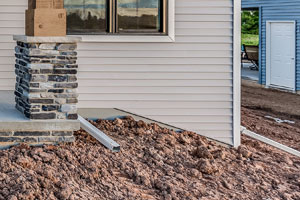
- Verify that the ground slopes away from the foundation.
- Stabilize any bare areas with grass, ground cover, or landscaping materials to discourage erosion. Dig out areas where sand has accumulated and fill in any low spots where necessary to reestablish drainage flow.
- Avoid overwatering plants and shrubs that are next to the foundation.
- Adjust sprinkler systems to avoid over spraying the house or causing puddles near the foundation.
- Plant trees and shrubs an adequate distance away from foundation to allow for mature spread and root systems.
- Water, fertilize, mow, and aerate your grass as necessary.
- In areas of the country with active (expansive) soils, follow maintenance and irrigation guidelines specific to your soils and foundation type. Conventional landscape practices may be inappropriate in these areas.
- For example, if your home has a pier-and-grade beam foundation and you live in a semi-arid climate, you may not be able to plant flowers or shrubs closer than five feet from the foundation, unless they have very low water requirements and can be hand or drip-line watered. Sprinkler systems may not spray closer than five feet from the foundation, and trees should not be planted closer than fifteen feet from the foundation.
- Conversely, if your home has a post-tensioned slab foundation in a moist climate, you may need to take steps to ensure that soils around foundation do not dry out excessively. Again, trees should not be planted closer than 15 feet from the foundation.
- Consult with your builder, nursery, or landscape professional, as necessary, to correct or learn more about your local soil and growing conditions.






